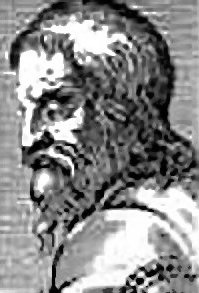Binot Paulmier de Gonneville facts for kids
Binot Paulmier de Gonneville was a French sailor from the early 1500s. Many people in France, especially in the 1600s and 1700s, believed he was the first European to discover a huge southern land called "Terra Australis." Today, history books in Normandy, France, teach that Binot Paulmier was a French-Norman navigator who reached what is now southern Brazil in 1504.
Contents
Who Was Binot Paulmier de Gonneville?
Binot Paulmier de Gonneville was a French navigator. He lived in the early 16th century. He came from Honfleur, a town in Normandy, France. He is known for a long sea voyage he made.
His Amazing Journey
In 1503, de Gonneville set sail from Honfleur. He had his crew and two Portuguese pilots with him. His goal was to reach the East Indies, a group of islands in Southeast Asia. This was a challenge because Portugal tried to control all sea routes. They believed the oceans were "closed seas" for their ships only.
De Gonneville's ship was named L'Espoir, which means "The Hope." When they reached the Cape of Good Hope, a big storm hit their ship. The storm pushed L'Espoir off course. It took them to a land that was "unknown" to them.
In 1505, de Gonneville returned to France. He claimed he had discovered a "great Austral land." He also called it the "Southern Indies." De Gonneville said he stayed in this wonderful place for six months. He described it as a rich land where people did not need to work hard. He also said this land was about six weeks' sail east of the Cape of Good Hope.
What Happened After His Return?
De Gonneville's story was not widely known right away. It was first mentioned about 160 years after his journey. In 1663, a relative named Jean Paulmier de Courtonne published a book. It was called Memoirs Concerning the Establishment of a Christian Mission in the Austral Land.
In his book, de Courtonne claimed to be the great-grandson of an "Indian" person. He said this person was brought back to France by de Gonneville in 1505. This book helped spread de Gonneville's tale.
Why Was His Story Important?
De Courtonne's claims became popular in France. At that time, French people felt a bit sad. The Dutch and English explorers were finding many new lands in the South Pacific. France wanted to make its own discoveries.
De Gonneville's tales became a reason for France to claim these new lands. This belief grew stronger in the 1700s. It led to many French expeditions. Famous explorers like Bouvet, Bougainville, and Kerguelen went on voyages. They were looking for new lands, partly inspired by de Gonneville's story.
Where Did He Really Go?
Historians have thought about many places where de Gonneville might have landed. Some believed it was the legendary Terra Australis. Others thought it might have been Madagascar.
Some historians believe he landed somewhere on the southern coast of Brazil. One theory, which is not fully proven, suggests he landed in São Francisco do Sul. This is a city in the state of Santa Catarina, Brazil.
Wherever he landed, de Gonneville brought one Indigenous boy back to France. The French called him Essomericq. This boy later married de Gonneville's daughter. A historian named Leyla Perrone-Moises wrote a great book on this topic. She says the exact place where de Gonneville landed is still unknown.
Celebrating His Legacy
Today, Binot Paulmier de Gonneville's supposed arrival in southern Brazil is celebrated every year. These celebrations happen in his hometown of Honfleur, France. They also take place on the island of São Francisco do Sul in Brazil. A special memorial plate has been put up there. It remembers the French explorer's arrival in 1504. However, it is important to remember that this story is more of a tale than a fully proven fact.
See also
 In Spanish: Binot Paulmier de Gonneville para niños
In Spanish: Binot Paulmier de Gonneville para niños


